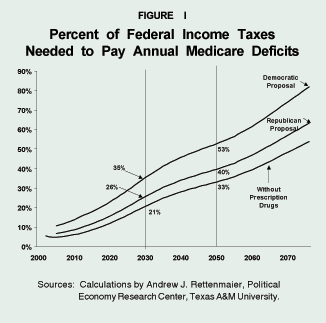Medicare currently pays only five percent of the cost of prescription drugs used by Medicare beneficiaries. Proposals to add a comprehensive prescription drug benefit to the program could shift as much as two-thirds of senior drug costs to Medicare. But this new benefit will increase the already substantial burden future Medicare expenditures will place on future taxpayers.
Fortunately, there is a better way.
Medicare's Shortcomings
Despite its political popularity, Medicare violates almost all principles of sound insurance. It pays too many small bills the elderly could easily afford themselves, while leaving them exposed to thousands of dollars of potential out-of-pocket expenses, including their drug costs. For instance, each year about 750,000 Medicare beneficiaries spend more than $5,000 out-of-pocket.
Medigap's Shortcomings
To prevent financial devastation from medical expenses, about two-thirds of Medicare beneficiaries acquire supplemental insurance, either through a former employer or by direct purchase. Most of these Medigap policies do not cover prescriptions, and coverage is often incomplete among those that do. Ironically, the poorest seniors often have the best drug coverage because they qualify for Medicaid, the federal-state health program for the poor.
Medicare's Unfunded Long-Term Liability
Medicare is a pay-as-you-go program, under which payroll tax revenues are spent on benefits as they are collected. No funds are set aside and invested to pay future benefits. This is a problem because anyone who has worked at least 10 years has already earned the right to receive future Medicare benefits even though no funds have been set aside to pay those benefits. A previous NCPA study by economists at the Private Enterprise Research Center at Texas A&M University estimated the current accrued liability under Medicare is almost $17 trillion. This is more than five times the level of the official national debt.
Of course, future payroll tax revenues will help meet these obligations. But Medicare is already spending more on benefits than it receives in payroll taxes (from workers), premiums (from the elderly) and taxes on Social Security benefits. In the future, the financial picture will get much worse.
Medicare's Future Deficits
Currently the annual deficit is funded by general government revenues – mainly personal and corporate income taxes. Figure I shows how much of federal income taxes will be needed to fund future Medicare deficits. Even without the addition of drug benefits, the long-term outlook for Medicare is very bleak:
- By 2030 – about the mid-point of the baby boomer retirement years – we will need 20 percent of income tax revenues just to make up the annual Medicare deficit.
- By 2050, when today's teenagers reach the retirement age, Medicare's annual deficit will require one-third of income taxes.
Transfers to Medicare from general revenues are only part of the picture. After 2017, Social Security will also require general revenue transfers:
- In 2030 Social Security will require about 14 percent of federal income tax revenues and Medicare and Social Security combined will consume more than 34 percent.
- By 2050 Medicare and Social Security will require more than 48 percent of all federal income tax revenues in addition to all dedicated taxes and premiums.
The House Democratic Proposal
Most Medicare prescription drug proposals stipulate deductibles, monthly premium payments, copays and ranges of copays, and the threshold at which 100 percent coverage begins. House Democrats have proposed coverage which includes a $100 deductible, $25 monthly premium, a 20 percent copay between $101 and $2,000, and 100 percent coverage beyond $2,000 in expenditures.
- Assuming all seniors participate, the likely result of the proposal is that Medicare would pay for about two-thirds of their drug costs.
- Our rough estimate is that this proposal will raise Medicare's deficit to 35 percent of income taxes by 2030 and 53 percent by 2050.
- When the deficit in Social Security is included, more than two-thirds of income tax revenues will be needed just to pay seniors' benefits by mid-century (see Figure II).
The House Republican Proposal
Republicans have proposed a benefit package which includes a $250 deductible, $34 monthly premium, a 20 percent copay between $251 and $1,000, a copay of 50 percent between $1,001 and $2,000, no coverage between $2,001 and $4,500, and 100 percent coverage beyond $4,500.
- Assuming all seniors participate, the likely result of this proposal is that Medicare would pay for a little more than one-fourth of their drug costs.
- Our rough estimate is that the GOP drug benefit will raise Medicare's claim on other revenue to 25 percent of income taxes by 2030 and 40 percent by 2050.
- When the Social Security deficit is included, 55 percent of income tax revenues will be needed just to pay seniors' benefits by mid-century (see Figure II).

Either proposal would shift costs for seniors' prescription drug purchases. Currently enrollees pay for 41 percent of the costs from their own pockets – with Medicaid, Medicare, and employer-sponsored and privately-purchased insurance picking up the rest. With a new prescription drug plan available, some private plans may drop out of the market, and Medicare will likely pick up some of the costs previously borne by Medicaid.
A Better Way
Seniors are the only people in our society who have to buy a second health plan to fill the gaps in the first. But even with Medicare and Medigap insurance, most do not have the same coverage for drugs nonseniors have. Moreover, paying two premiums to two plans is wasteful and inefficient. Paying a third premium to a third plan is even more wasteful and inefficient.
In a study for the National Center for Policy Analysis, Milliman & Robertson estimated that if the average Medicare expenditure were combined with the average Medigap premium and paid to a single plan, there is enough money to enroll seniors in the same type of health plans other Americans have. In other words, we do not need more money. We need structural change.